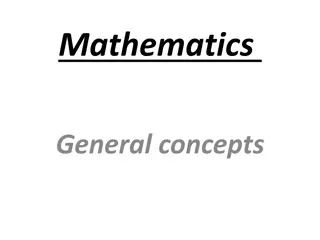Understanding Functions: Graphs, Formulas, and Data Analysis
Explore the world of functions through tables, graphs, formulas, and real-world examples based on the book "Functions, Data, and Models" by S.P. Gordon and F.S. Gordon. Learn how to represent functions graphically, interpret data tables, and analyze relationships between variables. Dive into the applications of functions in various contexts, such as metabolic rates, body mass, and population trends, to gain a deeper understanding of mathematical modeling.
Download Presentation

Please find below an Image/Link to download the presentation.
The content on the website is provided AS IS for your information and personal use only. It may not be sold, licensed, or shared on other websites without obtaining consent from the author. Download presentation by click this link. If you encounter any issues during the download, it is possible that the publisher has removed the file from their server.
E N D
Presentation Transcript
Functions Tables, Graphs, Formulas All slides in this presentations are based on the book Functions, Data and Models, S.P. Gordon and F. S Gordon ISBN 978-0-88385-767-0
Functions in the Real World What are the two variables? Which one depends on which? p. 2
Functions in the Real World What are the two variables? Which one depends on which? Metabolic rate R depends on the body mass M of an organism R is a function of M; a rule assigning values to R given a value of M p. 3
Body mass of mammals and birds (kg) versus their metabolic rates (watts) R is a linear function of M. How is it represented? Answer: Graphically p. 4
Four Representations of Functions Graphs for any value of M there is precisely one value of R associated with it Tables of data In words The taxi fare is determined as a flat rate of 2 USD plus .75 USD for each kilometer driven to the destination L Formulas: ? = ?? W p. 5
Formulas Area of a rectangle ? = ?? W L Example A = 10 x 4 = 40 Sq cm 4 cm 10 cm Perimeter of a rectangle P = 2W + 2L Example P = 2x10 + 2x4 = 28 cm p. 6
Formulas Area of a circle with radius r, ? = ??2 Conversion formula between Farenheit and Celsius temperature measurements ? =9 5 C + 32 The height of an object, H, dropped from the top of 180-foot-high Tower of Pisa ? = 180 16?2 p. 7
Data Tables U.S. population (in millions) in the years 1780 to 1900 This is a function since for each year there is precisely one value of the population p. 8
Data Tables Example Population of a given country (in millions) in the years 1900 to 2000 Is this a function? p. 9
Data Tables Population of a given country (in millions) in the years 1900 to 2000 Is this a function? No, there are two different values of the population in 1950 p. 10
Graphs Life expectancy in the US in 1900 to 2000 Show clearly any trends/patterns Life expectancy in the US in 1900 to 2000 For any given year there is exactly one value of the life expectancy for a child born in this year A child born in 1960 will have a life expectancy of about 70 years p. 11
Graphs Does every graph represent a function? How about a circle? p. 12
Why we study Functions Is a given quantity a function of another one? If there is a functional relationship, can we find a formula for it? If not, can construct a table or graph relating the two quantities? If we can find a formula, a table or a graph, how do we use it? p. 13
Connection between different representations of a function From formula to table ? = 180 16?2 Height is in feet; time in seconds p. 14
Connection between different representations of a function 1. From formula to graph When t = 0.5 second, the respective height is ? = 180 16 0.52= 180 16 0.25 = 180 4 = 176feet From graph to table read off a set of points and produce a respective table 2. From table to graph plot the point and connect them by a smooth curve to represent the function graphically 3. p. 15
From table to formula; from graph to formula Often in real life we have a data table and need to produce a formula to fit the given data points This is difficult but is made possible using modern technology We ll revisit this approach several times in our course in future classes p. 16
Behavior of Functions Increasing/Decreasing function p. 17
Behavior of Functions Not every quantity only increases/decreases Height of a bouncing ball Value of the Dow-Jones average Min temperature readings in a given location Local minimum/maximum (Turning Points) p. 18
Examples For each of the following functions, determine which are strictly increasing, strictly decreasing, or neither. The closing price of one share of Apple stock for each trading day on the stock exchange. The height H of a bungee jumper t seconds after leaping off a bridge. p. 19
Local Extrema On what intervals is the function increasing/decreasing? Decreases on the intervals t=0 to t=4 and t=6 to t=10 Increases on the intervals t=4 to t=6 and t=10 onwards Where are the turning points? Turning point at t=4, t=6 and t=10 What are the max/min values? Local minimum at t=4 and t=10 Local maximum at t=6 p. 20
Concavity how a function bends Suppose we have a strictly increasing or a strictly decreasing function. Increasing - graph rises from left to right Decreasing graph falls from left to right What is the difference between the given functions? p. 21
Concavity how a function bends Suppose we have a strictly increasing or a strictly decreasing function. What is the difference between the given functions? The way it bends. How fast does it increase/decrease initially and afterwards? p. 22
Concavity how a function bends How fast does it increase/decrease initially and afterwards? First increase slowly then faster, fig. 2.11 First increases rapidly then more slowly, fig. 2.11 How about the decreasing function? p. 23
Concavity how a function bends Concavity is different from monotonicity Concave UP Concave DOWN p. 24
Intervals of Concavity; Inflection points An Inflection point is where the graph changes it concavity p. 25
Logistic Growth Model It is important where the inflection point occurs Growth of a population Starts slowly Grows more and more rapidly Eventually the growth slows down again Limited resources play a role food, diseases, competition, etc. Sales of electronics p. 26
Summary A function is Increasing if its values increase as the argument increases Decreasing if its values decrease as the argument increases Turning point where the monotonicity changes Concave UP if the graph bends upwards Concave DOWN if the graphs bends downwards Inflection point - where bending of graph changes p. 27
Example Amount of profit from an investment over the course of 40 days from the day on which it was purchased p. 28
Periodic Behavior The tide at different times of the day near Montauk Point at the eastern end of Long Island p. 29























